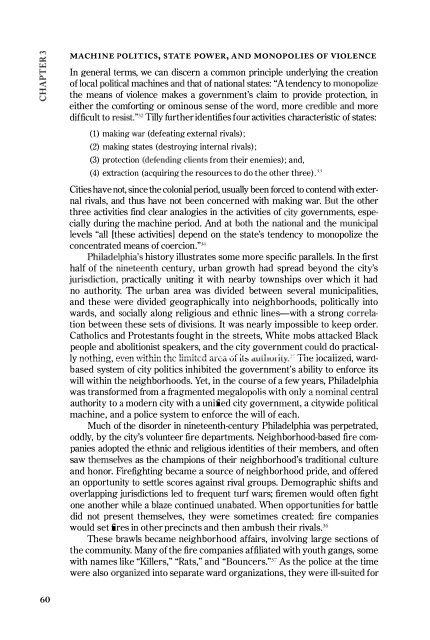Kristian Williams - Our Enemies in Blue - Police and Power in America
Kristian Williams - Our Enemies in Blue - Police and Power in America
Kristian Williams - Our Enemies in Blue - Police and Power in America
Create successful ePaper yourself
Turn your PDF publications into a flip-book with our unique Google optimized e-Paper software.
MACHINE POLITICS, STAT E POWER, AND MONOPOLIES OF VIOLENCEIn general terms, we can discern a common pr<strong>in</strong>ciple underly<strong>in</strong>g the creationof local political mach<strong>in</strong>es <strong>and</strong> that of national states: "A tendency to monopolizethe means of violence makes a government's claim to provide protection, <strong>in</strong>either the comfort<strong>in</strong>g or om<strong>in</strong>ous sense of the word, more credible <strong>and</strong> moredifficult to resist" 12 Tilly further identifies four activities characteristic of states:(1) mak<strong>in</strong>g war (defeat<strong>in</strong>g external rivals) ;(2) mak<strong>in</strong>g states (destroy<strong>in</strong>g <strong>in</strong>ternal rivals) ;(3) protection (defend<strong>in</strong>g clients from their enemies) ; <strong>and</strong>,(4) extraction (acquir<strong>in</strong>g the resources to do the other three) . '1Cities have not, s<strong>in</strong>ce the colonial period, usually been forced to contend with externalrivals, <strong>and</strong> thus have not been concerned with mak<strong>in</strong>g war. But the otherthree activities f<strong>in</strong>d clear analogies <strong>in</strong> the activities of city governments, especiallydur<strong>in</strong>g the mach<strong>in</strong>e period. And at both the national <strong>and</strong> the Illunicipallevels "all [these activities] depend on the state's tendency to monopolize theconcentrated means of coercion."';'Philadelphia's history illustrates some more specific parallels. In the firsthalf of the n<strong>in</strong>eteenth century, urban growth had spread beyond the city'sjurisdiction, practically unit<strong>in</strong>g it with nearby townships over which it hadno authority. The urban area was divided between several municipalities,<strong>and</strong> these were divided geographically <strong>in</strong>to neighborhoods, politically <strong>in</strong>towards, <strong>and</strong> socially along religious <strong>and</strong> ethnic l<strong>in</strong>es-with a strong correlationbetween these sets of divisions. It was nearly impossible to keep order.Catholics <strong>and</strong> Protestants fought <strong>in</strong> the streets, White mobs attacked Blackpeople <strong>and</strong> abolitionist speal\.ers, <strong>and</strong> the city government could do practicallynoth<strong>in</strong>g, even with<strong>in</strong> thc limited arta \Jf ib duLllUliLy.;: Tn e localized, wardbasedsystem of city politics <strong>in</strong>hibited the government's ability to enforce itswill with<strong>in</strong> the neighborhoods. Yet, <strong>in</strong> the course of a few years, Philadelphiawas transformed from a fragmented megalopolis with only a nom<strong>in</strong>al centralauthority to a modern city with a unified city government, a citywide politicalmach<strong>in</strong>e, <strong>and</strong> a police system to enforce the will of each.Much of the disorder <strong>in</strong> n<strong>in</strong>eteenth-century Philadelphia was perpetrated,oddly, by the city's volunteer fire departments. Neighborhood-based fire companiesadopted the ethnic <strong>and</strong> religious identities of their members, <strong>and</strong> oftensaw themselves as the champions of their neighborhood's traditional culture<strong>and</strong> honor. Firefight<strong>in</strong>g became a source of neighborhood pride, <strong>and</strong> offeredan opportunity to settle scores aga<strong>in</strong>st rival groups. Demographic shifts <strong>and</strong>overlapp<strong>in</strong>g jurisdictions led to frequent turf wars; firemen would often fightone another while a blaze cont<strong>in</strong>ued unabated. When opportunities for battledid not present themselves, they were sometimes created: fire companieswould set fires <strong>in</strong> other prec<strong>in</strong>cts <strong>and</strong> then ambush their rivals.56These brawls became neighborhood affairs, <strong>in</strong>volv<strong>in</strong>g large sections ofthe community. Many of the fire companies affiliated with youth gangs, somewith names like "Killers," "Rats," <strong>and</strong> "Bouncers.",7 As the police at the timewere also organized <strong>in</strong>to separate ward organizations, they were ill-suited for60


